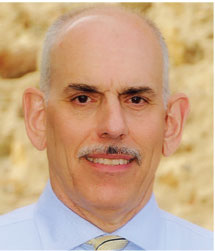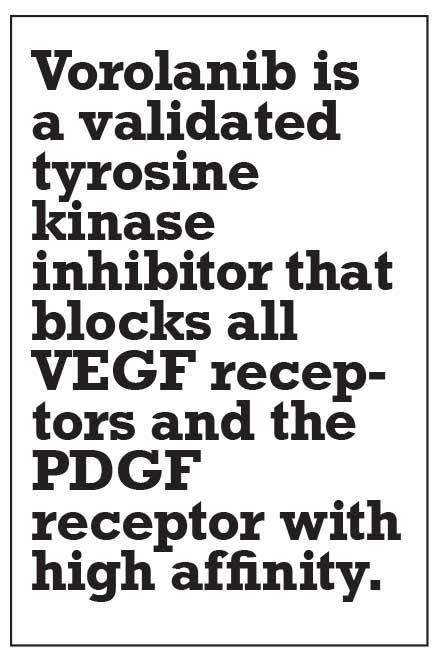| By Richard Mark Kirkner, Editor |
 |
Vorolanib is a small-molecule, tyrosine kinase inhibitor that’s been investigated as an oral treatment in patients with advanced solid tumors. It blocks downstream signaling of receptor tyrosine kinase activity, most notably, in both oncology and exudative retinal disease, vascular endothelial growth factor and platelet-derived growth factor receptors.1
And like the family of retinal anti-VEGF therapies, vorolanib has attracted interest as a potential treatment for neovascular age-related macular degeneration. EyePoint Pharmaceutical has been pursuing a program to develop EYP-1901, a bioerodible vorolanib-eluting implant using the Durasert platform, as a potential treatment for nAMD.
Recently reported interim eight-month results from the Phase I DAVIO trial have shown that 76 percent of eyes receiving the implant didn’t need rescue with anti-VEGF injections for up to four months; 53 percent went up to six months without rescue; and 41 percent went as long as nine months.2 The results showed a 79-percent reduction in treatment burden at six months and a 75- percent reduction at eight months, both of which were considered clinically significant.
With data from the DAVIO trial, EyePoint says it plans to initiate a Phase II trial later in the year. Here, David R. Lally, MD, of New England Retina Consultants in Springfield, Massachusetts, answers questions about EYP-1901 and the DAVIO trial. Dr. Lally is a primary investigator for the trial, and is a consultant to and speaker for EyePoint.
Q: Can you describe the idea behind EYP-1901?
A: The largest unmet need in wet AMD therapy is longevity of action of anti-VEGF therapies. The idea behind EYP-1901 is to give wet AMD patients and practitioners the flexibility to safely reduce the number of visits to the clinic through controlled and sustained—longer-lasting—intravitreal delivery of an anti-VEGF drug.
Q: What’s the mechanism of action of vorolanib, and how is the tyrosine kinase inhibitor (TKI) unique as a treatment for nAMD?
A: Vorolanib is a validated TKI that blocks all VEGF receptors and the PDGF receptor with high affinity. In this fashion, all isoforms of VEGF, the main driver of the proliferation of blood vessels that are the hallmark of wet AMD, should be inactivated by vorolanib.
Q: Can you describe the bioerodible properties of the insert?
 |
Q: How would this potentially fit into the retina specialist’s toolbox?
A: If EYP-1901 proves safe, effective, and well tolerated, it will likely be used as a maintenance treatment for appropriate wet AMD patients who have received prior treatment with currently available, standard-of-care anti-VEGFs. With EYP-1901, we hope that some or even a majority of wet AMD patients will be able to go many months between visits and injections while maintaining stable visual acuity and macular anatomy. There’s also a potential for achieving stability in other VEGF-dependent retina conditions, such as diabetic retinopathy and retinal vein obstruction.
Q: What’s the most compelling finding of the interim Phase I DAVIO results?
A: The eight-month data revealed that the reduction in treatment burden across all doses of EYP-1901 was substantial—approximately 80 percent—and no significant safety issues were observed.
Q: Can you talk a little about the trial design?
A: DAVIO is a Phase I multicenter, open-label, dose-escalation clinical trial that enrolled 17 patients, all of whom were diagnosed with wet AMD at least four months prior and received previous treatment for it. There were no exclusions for the presence of macular fluid at the time of enrollment, and the trial didn’t include a control arm.
For eligibility, patients must have received at least three prior injections with an anti-VEGF product (bevacizumab, ranibizumab or aflibercept) in the six months prior to the screening visit, in the study eye.
The trial was designed as a 12-month study with an interim analysis planned at six months, and patients were observed monthly at a minimum. The primary endpoint was safety, and key secondary endpoints included best-corrected visual acuity and central subfield thickness as measured by optical coherence tomography.
One injection of EYP-1901 was given at day zero of the study. No retreatments (reinjections) with EYP-1901 occurred in this trial.
Criteria for rescue with standard-of-care anti-VEGF therapy included new fluid >75 µm from day zero, the loss of two or more lines in VA due to wet AMD, and/or new macular hemorrhage due to wet AMD.
Q: How will this help inform the Phase II trial?
A: Because of the safety and apparent efficacy seen in the Phase I trial, the Phase II wet AMD trial will commence later in the year. As with most early trials, Phase I will help to inform the dosing and inclusion/exclusion criteria of Phase II, while the excellent safety profile will give assurance to participating patients and investigators.
Q: Anything else to add?
A: With a minimum of eight months follow-up, seven of the 17 (41 percent) patients from the DAVIO Phase I trial remain rescue-free.
The company plans on starting a Phase II diabetic retinopathy study in 2022 and a third Phase II study, most likely in retinal vein occlusion, in 2023.
Further, with the success of the DAVIO Phase I trial, the bioerodible form of Durasert will likely be tested with other small molecules and other mechanisms of action. RS
REFERENCES
1. Song Y, Wang J, Ren X, et al. Vorolanib, an oral VEGFR/PDGFR dual tyrosine kinase inhibitor for treatment of patients with advanced solid tumors: An open-label, phase I dose escalation and dose expansion trial. Chin J Cancer Res. 2021;33:103-114.
2. Duker JS. 8-month results of a tyrosine kinase inhibitor (vorolanib) in a bio-erodible Duraset implant for previously treated wet AMD: The DAVIO trial. Paper presented at Angiogenesis, Exudation, and Degeneration 2022 virtual meeting; February 12, 2022.



